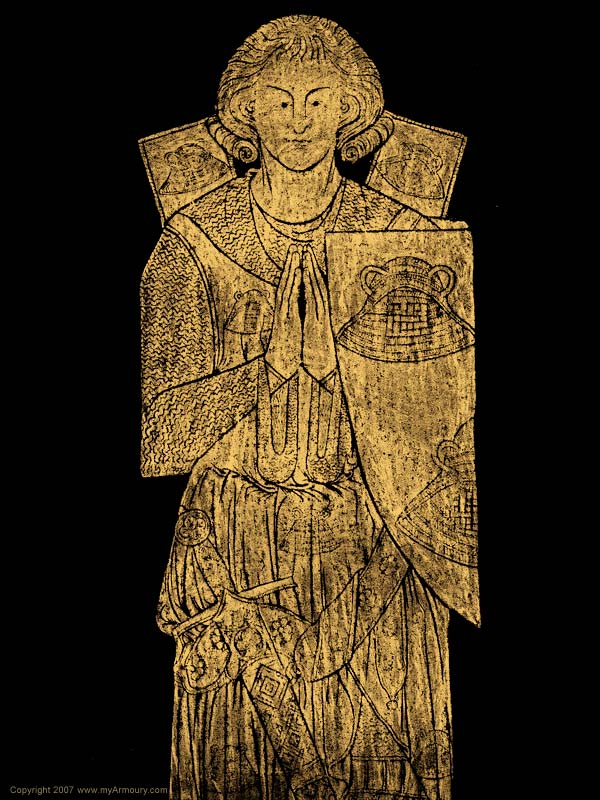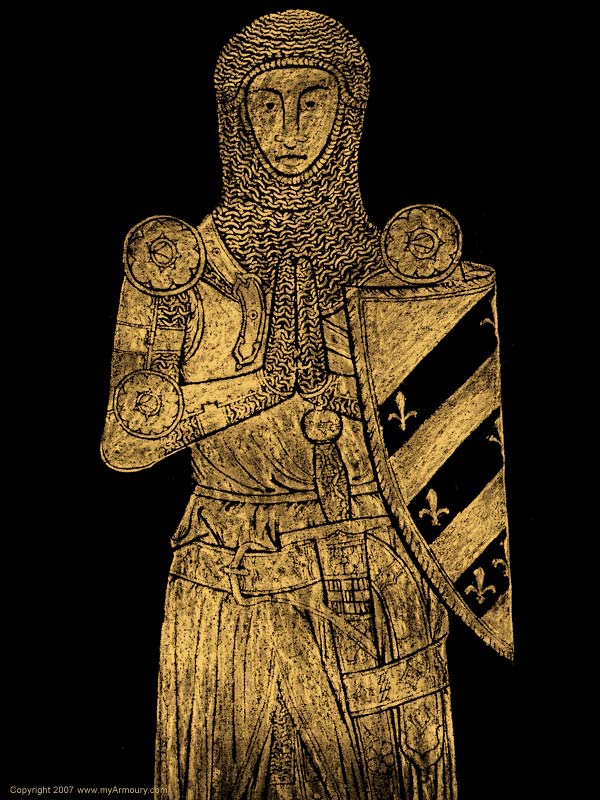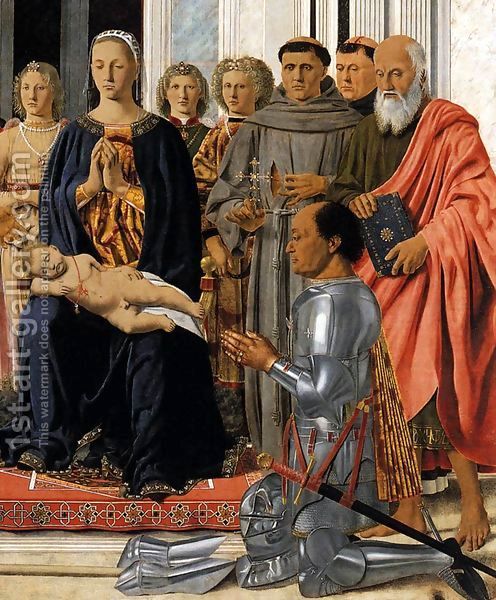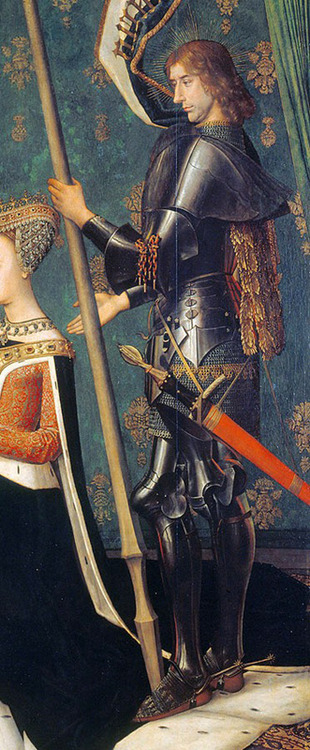| Author |
Message |
|
Levente M.
Location: Hungary Joined: 19 Aug 2009
Posts: 35
|
 Posted: Sun 12 Aug, 2012 7:53 am Post subject: Common man's scabbard of late 14th century England Posted: Sun 12 Aug, 2012 7:53 am Post subject: Common man's scabbard of late 14th century England |
 |
|
So we know how the scabbards of knights and nobles looked like, and how they were attached to the plaque belt in the late 14th century, from effigies (England). I'm sure everyone is familiar with the swords "magically glued" to the belt.
However, I was wondering what a common footsoldier or non-knightly, poorer man-at-arms would use to attach the scabbard to his belt? They obviously didn't have plaque belts, and scabbards must have been much simpler as well. I haven't found anything about this topic.
Does anyone have any info on this?
Thanks!
|
|
  |
 |
|
Jeremy V. Krause
|
 Posted: Sun 12 Aug, 2012 8:32 am Post subject: Posted: Sun 12 Aug, 2012 8:32 am Post subject: |
 |
|
If you had a sword in the 14th. c. I really don't think you could be but so poor.
Scabbards were more perishable than the sword they housed and a sword would have likely had a few in it's working life.
I would say that the integral belt scabbards you see around the site would be pretty typical of a scabbard for a non-knight, or even knight of the early to mid 14th c.
Last edited by Jeremy V. Krause on Sun 12 Aug, 2012 4:20 pm; edited 1 time in total
|
|
  |
 |
Ben Anbeek
Industry Professional

|
 Posted: Sun 12 Aug, 2012 10:11 am Post subject: Posted: Sun 12 Aug, 2012 10:11 am Post subject: |
 |
|
there was a dig in Leiden (netherlands) they found 117 14th century sword scabbards. (probably waste from a scabbard maker)
22 of these scabbards had decorations in the leather and some had parallel lines a round the edge.
most of the scabbard have slits in them for a looped belt.
so based on these findings i would say that the integral belt scabbards are common
Medieval Goods
http://www.theupperclass.nl
www.facebook.com/TheUpperClass.nl
|
|
   |
 |
|
Kel Rekuta
|
 Posted: Sun 12 Aug, 2012 3:22 pm Post subject: Posted: Sun 12 Aug, 2012 3:22 pm Post subject: |
 |
|
Ben,
Would you be so kind as to share the source of this information - an article in an academic journal perhaps?
|
|
   |
 |
T. Arndt

|
 Posted: Sun 12 Aug, 2012 8:26 pm Post subject: Posted: Sun 12 Aug, 2012 8:26 pm Post subject: |
 |
|
| Jeremy V. Krause wrote: | | If you had a sword in the 14th. c. I really don't think you could be but so poor. |
This.
At least not so poor so to not have a nice scabbard. 
Wisconsin Historical Fencing Association (WHFA) - La Crosse
A HEMA Alliance Affiliate
“Quis custodiet ipsos custodes?” -Juvenal
|
|
   |
 |
Robin Smith

|
 Posted: Mon 13 Aug, 2012 5:57 am Post subject: Posted: Mon 13 Aug, 2012 5:57 am Post subject: |
 |
|
| T. Arndt wrote: | | Jeremy V. Krause wrote: | | If you had a sword in the 14th. c. I really don't think you could be but so poor. |
This.
At least not so poor so to not have a nice scabbard.  |
I dunno... I seem to remember reading that by the HYW, the price of a sword was only a couple days wage for a normal soldier. They certainly weren't the immensely expensive objects they were a few centuries earlier.
A furore Normannorum libera nos, Domine
|
|
   |
 |
|
Sean Manning
|
 Posted: Mon 13 Aug, 2012 7:50 am Post subject: Posted: Mon 13 Aug, 2012 7:50 am Post subject: |
 |
|
|
The OP said "common foot-soldier or poorer man at arms." Neither would be absolutely poor in late 14th century England, but some men-at-arms were poor relative to others. In England around 1300 you could easily buy a sword suitable for a knight for 40d, and something that was supposed to be a sword for a few pence, with wages for a country carpenter around 3d/day.
|
|
  |
 |
Ben Anbeek
Industry Professional

|
|
   |
 |
James Barker

Location: Ashburn VA Joined: 20 Apr 2005
Posts: 365
|
 Posted: Tue 14 Aug, 2012 4:46 am Post subject: Posted: Tue 14 Aug, 2012 4:46 am Post subject: |
 |
|
| Ben Anbeek wrote: | Hi Kel
The information comes from a small Dutch publication called:
veertiende eeuwse zwaardscheden uit leiden By C van Driel-Murray
I.p.p Publicatie 276/277 (1980) |
I am going to guess this is not in English. 
James Barker
Historic Life http://www.historiclife.com/index.html
Archer in La Belle Compagnie http://www.labelle.org/
|
|
   |
 |
Ben Anbeek
Industry Professional

|
|
   |
 |
|
Jeremy V. Krause
|
 Posted: Tue 14 Aug, 2012 10:39 am Post subject: Posted: Tue 14 Aug, 2012 10:39 am Post subject: |
 |
|
I've got to say I am a bit skeptical of poster's citations of such "affordable" swords relative to labor, wages, value of money, social stratification, etc, however, I AM willing to be convinced given sufficient proof. 
It simply doesn't square with my conceptions of the military life- even with the admitted emergence of the bourgeois class we see in the 14th. c. Yes, social structure does change relative to the 13th. c., and definitely, the 12th. c. The increased organization of trade guilds and urban living would have "blended" the social stratification to a degree, allowing for more affordable military goods. I just, at this point, can't accept that a three day wage, or a weeks wage of a tradesman, could buy a sword. I also suspect that even if swords became less costly OTHER ancillary costs related to the soldier's status would make purchasing weapons unrealistic for an individual without some degree of wealth and connections.
But long story short, in my opinion, and that's all it is, you could have "less wealthy" individuals owning swords but not "struggling" individuals. Also, keep in mind we are talking the EVTIRE 14th. c., AND not specifying a given locale, or a specific political or military macro-level contemporary event. Undoubtedly, all of this would effect this global question.
Still, regarding scabbards and the OP. A straight integral belt system like those seen around myArmoury with tasteful decoration would make sense even if attempting to show a relatively less wealthy soldier, mercenary, knight, men-at-arms. . . . If someone had a sword then they had a descent average, well-built, and custom scabbard.
In the past labor was cheap and materials were expensive, not like today.
I don't personally, agree with the historical accuracy with so called "campaign scabbards" we see from time to time- with simplified and blocky presentations.
|
|
  |
 |
Thomas R.

|
 Posted: Tue 14 Aug, 2012 11:04 am Post subject: Posted: Tue 14 Aug, 2012 11:04 am Post subject: |
 |
|
Hi,
in my opinion most modern scabbards are overdecorated with too much leatherwork and metal. Most don't even fit the timeframe of the sword, they were made for. Don't misunderstand me: they do look very nice and pleasing, and have a very aestethical look, but they are not, what I've seen in period illuminations and portraits.
These scabbards were mostly very plain, even if wealthy men owned them. I think, our ancestors knew, that the scabbard was a discardable item, like a shield. They put a metal scape on the tip (which could be reused and extended the lifespan of the scabbard!) and sow the leather onto the core, so that they could exchange it easily after some wear and tear. The scabbard was meant to protect its contents, not to be an artwork in itself. In the renaissance and later times this may have changed, since some swords were then regarded as artworks. But even in the late 15th century we do find wealthy warriors and saints depicted with plain, undecorated scabbards. I regard many of the modern scabbards as very well executed fantasy stuff.
Thomas
http://maerenundlobebaeren.tumblr.com/
|
|
   |
 |
|
Sean Manning
|
 Posted: Tue 14 Aug, 2012 11:23 am Post subject: Posted: Tue 14 Aug, 2012 11:23 am Post subject: |
 |
|
| Jeremy V. Krause wrote: | I've got to say I am a bit skeptical of poster's citations of such "affordable" swords relative to labor, wages, value of money, social stratification, etc, however, I AM willing to be convinced given sufficient proof. 
It simply doesn't square with my conceptions of the military life- even with the admitted emergence of the bourgeois class we see in the 14th. c. Yes, social structure does change relative to the 13th. c., and definitely, the 12th. c. The increased organization of trade guilds and urban living would have "blended" the social stratification to a degree, allowing for more affordable military goods. I just, at this point, can't accept that a three day wage, or a weeks wage of a tradesman, could buy a sword. I also suspect that even if swords became less costly OTHER ancillary costs related to the soldier's status would make purchasing weapons unrealistic for an individual without some degree of wealth and connections.
|
Have a look at the PhD thesis of Randall Storey (Technology and Military Policy in Medieval England, c.1250-1350, University of Reading, 2003), especially Appendix 1. It used to be available online at http://medievalhistory.mysite.wanadoo-members.co.uk/thesis.html and is still up on the Wayback Machine. It gives the minimum, average, and maximum prices of swords in fifteen times where swords are given a price or value in England from 1294 to 1339. The cheapest was 2d, the dearest 10s, the average 3s 5d. The real cost of being a soldier in late medieval England was horses, armour, and training; you could easily buy a spear, target, and knife for 15d but just a gambeson and iron cap might cost 60d.
|
|
  |
 |
|
Kel Rekuta
|
 Posted: Tue 14 Aug, 2012 11:29 am Post subject: Posted: Tue 14 Aug, 2012 11:29 am Post subject: |
 |
|
| Ben Anbeek wrote: | | no it's in dutch. sorry |
But my resident genius reads and speaks Dutch... and thinks she's seen that article. :-}
Ben, if you are willing to share a copy of the article, I would be very grateful. Ariella will sort it out for us.
Cheers!
|
|
   |
 |
|
Sean Manning
|
 Posted: Tue 14 Aug, 2012 11:32 am Post subject: Posted: Tue 14 Aug, 2012 11:32 am Post subject: |
 |
|
| Kel Rekuta wrote: | | Ben Anbeek wrote: | | no it's in dutch. sorry |
But my resident genius reads and speaks Dutch... and thinks she's seen that article. :-}
Ben, if you are willing to share a copy of the article, I would be very grateful. Ariella will sort it out for us.
Cheers! |
I wish her luck, because Worldcat only knows of one copy, in Leiden. I can't find any online booksellers which have it, and if published in 1986 its probably long out of print.
|
|
  |
 |
Ben Anbeek
Industry Professional

|
|
   |
 |
Chad Arnow
myArmoury Team


|
 Posted: Tue 14 Aug, 2012 4:15 pm Post subject: Posted: Tue 14 Aug, 2012 4:15 pm Post subject: |
 |
|
| Thomas R. wrote: | These scabbards were mostly very plain, even if wealthy men owned them. I think, our ancestors knew, that the scabbard was a discardable item, like a shield. They put a metal scape on the tip (which could be reused and extended the lifespan of the scabbard!) and sow the leather onto the core, so that they could exchange it easily after some wear and tear. The scabbard was meant to protect its contents, not to be an artwork in itself. In the renaissance and later times this may have changed, since some swords were then regarded as artworks. But even in the late 15th century we do find wealthy warriors and saints depicted with plain, undecorated scabbards. I regard many of the modern scabbards as very well executed fantasy stuff.
Thomas |
What about all the brasses and effigies that show highly tooled scabbards? Are you chalking all that up to artistic license?
Here are a couple (cropped, unfortunately):



ChadA
http://chadarnow.com/
|
|
    |
 |
|
Kel Rekuta
|
 Posted: Tue 14 Aug, 2012 5:51 pm Post subject: Posted: Tue 14 Aug, 2012 5:51 pm Post subject: |
 |
|
| Sean Manning wrote: | | Kel Rekuta wrote: | | Ben Anbeek wrote: | | no it's in dutch. sorry |
But my resident genius reads and speaks Dutch... and thinks she's seen that article. :-}
Ben, if you are willing to share a copy of the article, I would be very grateful. Ariella will sort it out for us.
Cheers! |
I wish her luck, because Worldcat only knows of one copy, in Leiden. I can't find any online booksellers which have it, and if published in 1986 its probably long out of print. |
You would be amazed what publications lie in the PIMS Library at Uof Toronto. Much of that collection is inaccessible without venturing in there. I am constantly surprised by the stuff Ariella and colleagues find for us. Anyway, if Ben can find time to share his copy, a working translation will happen. I know just the bribes required. ;-)
|
|
   |
 |
Thomas R.

|
 Posted: Wed 15 Aug, 2012 12:29 am Post subject: Posted: Wed 15 Aug, 2012 12:29 am Post subject: |
 |
|
[quote="Chad Arnow"]
What about all the brasses and effigies that show highly tooled scabbards? Are you chalking all that up to artistic license?
Here are a couple (cropped, unfortunately):
/quote]
Hi Chad,
thanks for these pictures! But I think, an effigy was designed to inspire awe for the knight in his grave. The artist could have chiseled as many ornaments, as he can - without even seeing the actual scabbard. Or even a couple of years after the death of the knight, going with the fashion. So I think, the decorations are exaggerated. Look at this portrait of Federico Montefeltro. He was a very influential and wealthy man, but he shows it in other aspects than his scabbard. The artist could have made up any ornaments, too, but everybody would have seen his scabbard and known, it's not the real thing. Not so on an entombed knights effigy. Another example from late 15th century is the depiction of St. George, I added. In my opinion most modern scabbards are made to please our longing for a somehow romanticized middle age. And that's ok. I don't say there were no tooling back in period, like the occasional cross or line, especially in the high medieval era, but not to an extent, we see in high end reproductions today.
Best regards,
Thomas
 Attachment: 84.23 KB Attachment: 84.23 KB

 Attachment: 146.7 KB Attachment: 146.7 KB

http://maerenundlobebaeren.tumblr.com/
|
|
   |
 |
Ben Anbeek
Industry Professional

|
|
   |
 |
|
|
You cannot post new topics in this forum
You cannot reply to topics in this forum
You cannot edit your posts in this forum
You cannot delete your posts in this forum
You cannot vote in polls in this forum
You cannot attach files in this forum
You can download files in this forum
|
All contents © Copyright 2003-2024 myArmoury.com — All rights reserved
Discussion forums powered by phpBB © The phpBB Group
Switch to the Basic Low-bandwidth Version of the forum
|

